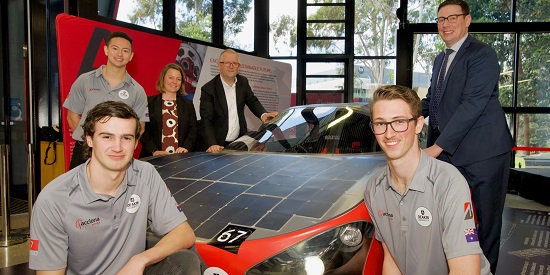Deakin solar car shines bright as only Victorian entrant in 2023 Bridgestone World Solar Challenge
Media release
Deakin University's Vice-Chancellor Professor Iain Martin has farewelled 14 students and six staff from the School of Engineering as they set off to take part in the 2023 Bridgestone World Solar Challenge (BWSC), a design competition to discover the world's most efficient electrical car.
The Deakin ASCEND team is the only Victorian entry, alongside 41 other teams from 23 countries, with the aim of pushing the limits of technological innovation while travelling through the Australian outback in a vehicle powered only by the energy of the sun.
It is the first time Deakin has participated.
In wishing the team well, Professor Martin said:
"I'd like to congratulate the Deakin ASCEND team on their determination, perseverance and focus on designing and building a practical solar vehicle. This is exactly the kind of project that aligns with Deakin's values and commitment to sustainability and energy."
"This priority is written into our 10-year strategic plan and is very deliberately linked to our activities across education, research and innovation," said Vice-Chancellor Professor Martin.
"With the energy transition upon us, this project has provided a platform for students to engage with a real-world challenge – to design and build a solar car fit to be driven on our roads."
The race starts on October 22 in Darwin and will finish 3000km later in Adelaide. Deakin ASCEND will compete with ten other teams in the Cruiser class; concept cars that may come to market one day.
Cruiser Class cars must be practical, seat a minimum of two people and manage their energy requirements over 1000 km stages and meet strict time targets.
During the event they will be part of experiments conducted by Australia's peak scientific body CSIRO, measuring the impact of electric vehicles on the electricity supply network.
Once in Adelaide Cruiser Class teams present their cars to a panel of judges who will award a 'practicality' score, emulating the real-world problem industrial designers face every day.
Head of the School of Engineering Professor Ben Horan said:
"Participating in the BWSC is an opportunity to showcase Deakin's strengths in sustainable innovation through additive manufacturing, engineering design and product development, and to provide exceptional learning experiences.
"Since 2019, the ASCEND Solar Car Project has engaged more than 1000 students, representing disciplines from mechanical, electrical and aerodynamics engineering to information technology, business, marketing, and communication. Participation in this real-world project gives students hands-on experience and an embedded knowledge of how the industry works."
The challenge, said Professor Martin, comes at a time when Australia desperately needs more engineers. Australia will be an estimated 50,000 engineers short by 2030.
"There is no more important time than now to undertake such a challenge that inspires and challenges the next generation of engineers. We couldn't be prouder to see our Deakin team on the world stage," Professor Martin said.
ABOUT DEAKIN'S ASCEND SOLAR CAR
ASCEND = ACCIONA Solar Car Engineered by Deakin
Overall length (m) = 4.93 M
Overall width (m) = 2.0 M
Overall height (m) = 1.29 M
Ride Height = 200 mm
Wheelbase = 2.86 M
Weight (kg) = 700kg
Cruising Speed = 80 km/h
Top Speed = 130 km/h
Battery Capacity = 60kW/h
Torque = 200 Mn
CO2 EMISSIONS = 0 😊
MOTORS
Two EMRAX 188 MV Motors provide ASCEND optimum acceleration and power while using minimal energy. These electric motors can produce 80 horsepower and nearly 100 Nm of torque each. They weigh 7 kg and are less than 200mm in diameter. The motors are controlled through a high-efficiency Prohelion Wavesculptor 22, resulting in a system with over 90% efficiency.
SOLAR ARRAY
A 5m2 array of Sunpower® Maxeon® solar cells have been encapsulated with a form of Teflon that stops dust collecting and reducing the efficiency of the solar panels. These flexible solar cells conform to the curves of the car and have an energy generation capacity of over 1500 w, 29% more than conventional solar in the same space.
BATTERY
Two batteries power ASCEND - A 20 kW/h and 40 kW/h Lithium-Ion Battery pack manufactured by Prohelion. They are made from hundreds of cells, giving an average voltage of 135 v. ASCEND has a total battery capacity of 60 kW/h, which is about the same as a 2022 Tesla Model 3.
CHARGING
ASCEND can be charged through its solar array or at most electric charging stations. A traditional electric vehicle charger will take 10 hours to charge both batteries from empty to full, with up to 1500 km of range from one charge at a cruising speed of 80 km/h.
LIGHTWEIGHT DESIGN
Careful material selection and stress analysis ensure that components are strong as well as lightweight. The chassis uses thin-walled Chromoly tubing and weighs less than 85 kg. Using generative designed 3D-printed titanium front uprights and CNC-milled aluminium suspension arms all combine to make ASCEND half the weight of a regular car.
BODY PANELS
Body panels are modelled in CAD and 3D printed with nylon powder using Multi-Jet Fusion technology to eliminate the need for waste and moulds. Multi-Jet Fusio has production rates much faster than traditional 3D printing technologies. Tough and strong the nylon panels can be sanded and polished to get a smooth exterior finish.
FUTURE MATERIALS
Composites of basalt fibre and eco bio-resins are used to reinforce the car body as well as keep it lightweight. Basalt fibre is made from volcanic rock, melted, and stitched or woven into fabrics. Deakin researchers are applying these materials to a real-world environment to see how they perform.
WHEELS & TYERS
Student-designed wheels are CNC machined from aluminium to ensure they are light and strong.
Bridgestone has sponsored ASCEND with tyres designed specifically for solar cars to reduce rolling resistance. These very skinny tyres are hyper-efficient, allowing the car to maintain its grip and stability while also improving its range.

